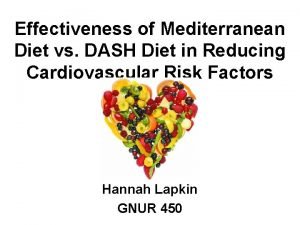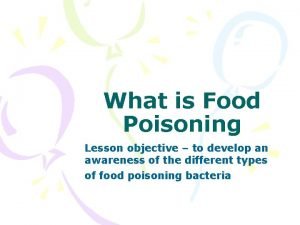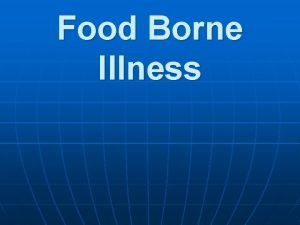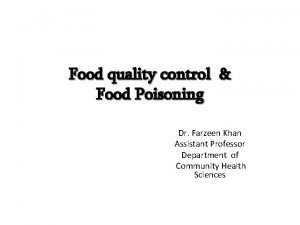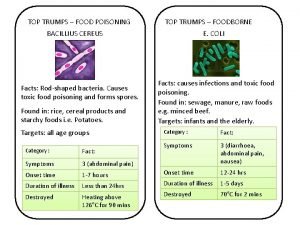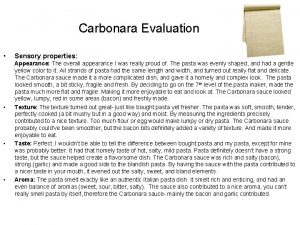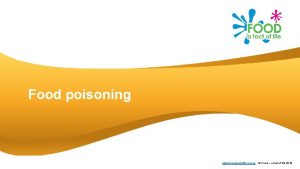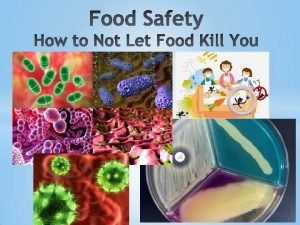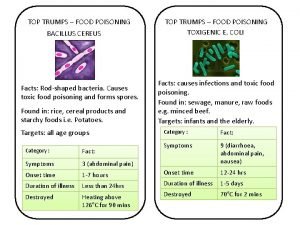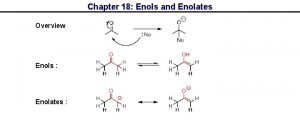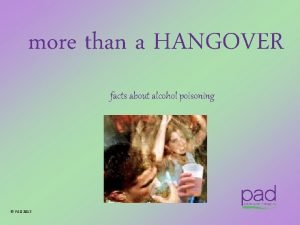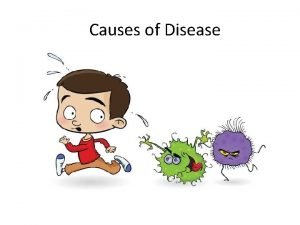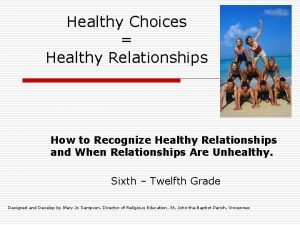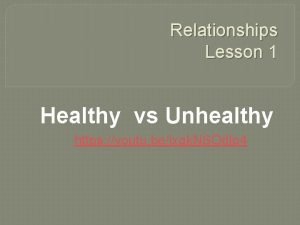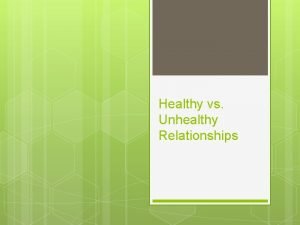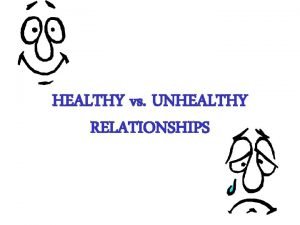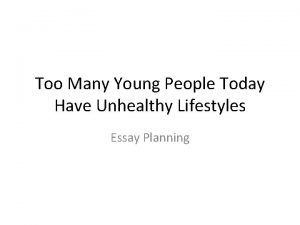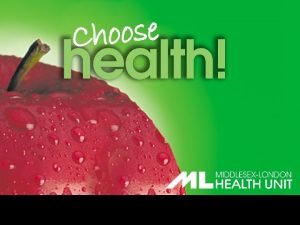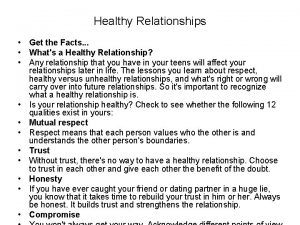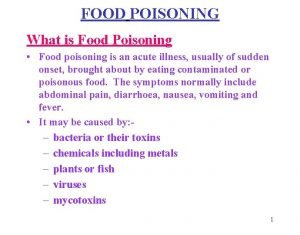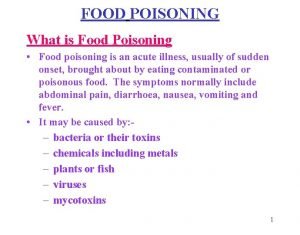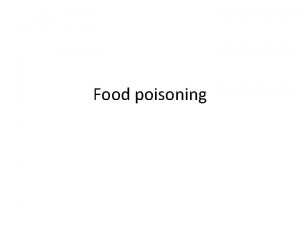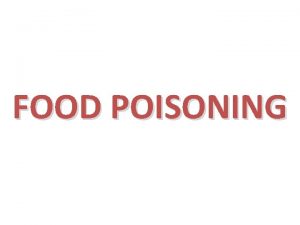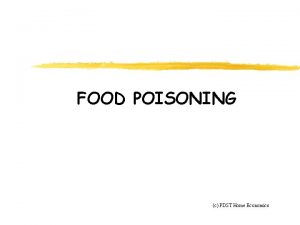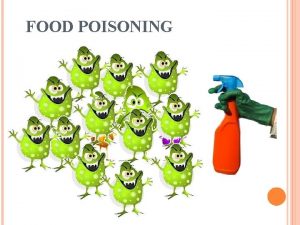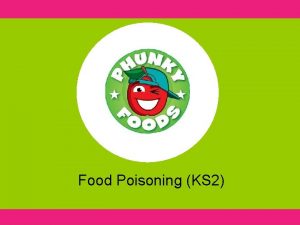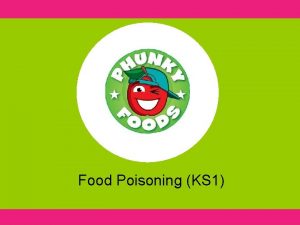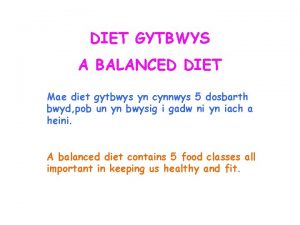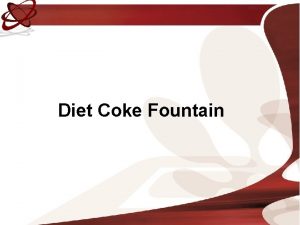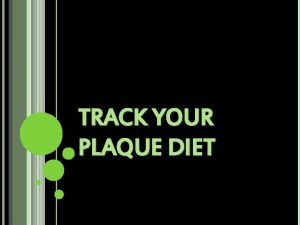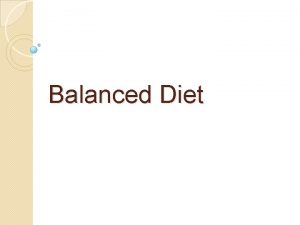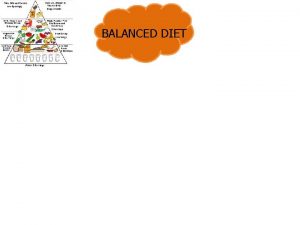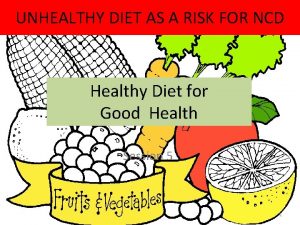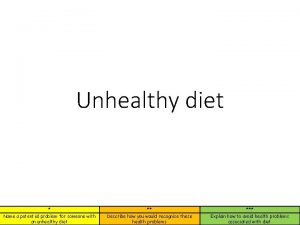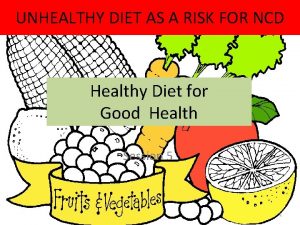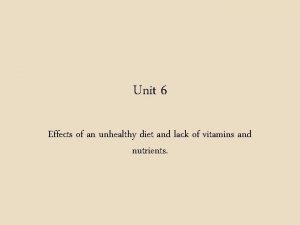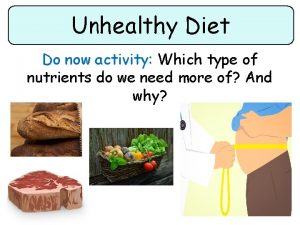UNHEALTHY DIET FOOD POISONING Food poisoning is an



























- Slides: 27

UNHEALTHY DIET

FOOD POISONING Food poisoning is an ever-present threat that can be prevented with proper care and handling of food products. It is estimated that between 24 and 81 million cases of food borne diarrhea disease occur each year in the United States, costing between $5 billion and $17 billion in medical care and lost productivity.

CAUSES OF FOODPOISONING Microorganisms (bacteria, viruses, parasitic) natural toxins, and chemical residues. Bacteria. The mechanisms by which food-borne bacteria cause illness include the production of toxin in food before it is eaten or the production of toxin in the intestine, multiplication of the organism in the intestine

Illness is usually characterized by rapid onset, within hours or days, of vomiting and diarrhea, which may last a few hours or days in healthy people.

Common Bacteria Causing Food Poisoning Bacteria Main Symptoms Incubation Staphylococcus aureus Vomiting 2 – 6 hours Bacillus cereus Vomiting or diarrhea 1 – 16 hours Clostridium botulinum (botulism) Headache, double vision, paralysis, death 12 – 96 hours Produce toxins in food:

Common Bacteria Causing Food-Borne Illness Bacteria Main Symptoms Incubation Diarrhea, stomach pains 8 – 22 hours Salmonellaspecies Diarrhea, fever, headache, some vomiting 6 – 48 hours Campylobacterspecies Fever, headache, diarrhea, stomach pains, nausea 2 – 8 days Escherichia coli Cramps, vomiting, fever, bloody diarrhea, hemolytic uremic syndrome (HUS) 1 – 5 days Shigellaspecies Diarrhea, vomiting, fever, cramps 1 – 7 days Yersinia enterocolitica Diarrhea, fever, severe abdominal and joint pain 1 – 7 days Release toxins in intestines: Clostridium perfringens Rapid multiplication in intestine:

Food-handling practices commonly linked to outbreaks of bacterial food-borne disease Factor contributing to outbreaks Salmonella Clostridium Perfringens Staphylococus Aureus Bacillus Cereus Food prepared too early √ √√ Stored at room temperature √ √√ Not properly cooked √ √√ √ Not properly reheated √ √√ √√ Undercooked √ Contaminated canned food √ Not properly thawed √ Cross contamination √ Improper warm holding Infected food handler √ √ √

PREVENTION Normally a large number of food-poisoning bacteria must be present to cause illness. Therefore, illness can be prevented by (1) controlling the initial number of bacteria present, (2) preventing the small number from growing, (3) destroying the bacteria by proper cooking (4) avoiding re-contamination

PREVENTION OF FOOD POISONING Wash your hands, utensils and food surfaces often Wash knives and cutting surfaces with hot, soapy water after contact with raw meat or poultry. Keep raw foods separate from ready-to-eat foods Separate your meat and poultry products from the rest of your groceries. Tightly wrap raw meat packages in plastic bags so that leaking juices won't contaminate other food. Use separate cutting boards for raw meats and other ready-to-eat foods such as breads and vegetables. .

Use one plate for raw meats and use another plate after the meat is cooked Cook foods to a safe temperature Cook meat and poultry thoroughly Tightly wrap meat, poultry and fish so the juices don't drip on other food as they thaw in the refrigerator Cook food immediately after defrosting Don't drink unpasteurized milk or dairy products Don't eat raw or undercooked eggs or foods that may contain them Don't leave high-risk foods at room temperature for more than two hours, or above 90 F for more than one hour.

Don't eat raw oysters. Make sure all fish and shellfish are thoroughly cooked Wash fruits and vegetables thoroughly before eating them Divide large volumes of food into small portions for rapid cooling in the refrigerator. Hot, bulky foods in the refrigerator can raise the temperature of foods already cooled.

Serve hot foods immediately or keep them heated above 140 degrees F. The temperature range in which most bacteria grow is between 40 degrees F (5 degrees C) and 140 degrees F (60 degrees C). Raw and cooked foods should not be kept in this danger zone any longer than absolutely necessary. Remember the danger zone is between 40 degrees F and 140 degrees F. When in doubt, throw it out

TO THAW FOOD SAFELY, CHOOSE ONE OF THESE OPTIONS: Thaw in the refrigerator. This is the safest way to thaw meat, poultry, and seafood. Simply take the food out of the freezer and place it on a plate or pan that can catch any juices that may leak. Normally, it should be ready to use the next day. Thaw in cold water. For faster thawing, you can put the frozen package in a watertight plastic bag and submerge it in cold water. Be sure to change the water every 30 minutes. Note: If you thaw this way, be sure to cook the food immediately. Thaw in the microwave. Faster thawing can also be accomplished in the microwave. Simply follow instructions in your owner’s manual for thawing. As with thawing in cold water, food thawed in the microwave should be cooked immediately. Cook without thawing. If you don’t have enough time to thaw food, just remember, it is safe to cook foods from a frozen state— but your cooking time will be approximately 50% longer than fully thawed meat or poultry.

STORAGE TIMES FOR THE REFRIGERATOR AND FREEZER HTTP: //WWW. FOODSAFETY. GOV/KEEP/CHARTS/STORAGETIMES. HTML Category Food Salads Egg, chicken, ham, tuna & macaroni salads Hot dogs Refrigerator (40 °F or below) Freezer (0 °F or below) 3 to 5 days Does not freeze well opened package 1 week 1 to 2 months unopened package 2 weeks 1 to 2 months 3 to 5 days 1 to 2 months 2 weeks 1 to 2 months 7 days 1 month Sausage, raw — from chicken, turkey, pork, beef 1 to 2 days 1 to 2 months Hamburger & Other Ground Meats Hamburger, ground beef, turkey, veal, pork, lamb, & mixtures of them 1 to 2 days 3 to 4 months Fresh Beef, Veal, Lamb & Pork Steaks 3 to 5 days 6 to 12 months Chops 3 to 5 days 4 to 6 months Roasts 3 to 5 days 4 to 12 months Chicken or turkey, whole 1 to 2 days 1 year Chicken or turkey, pieces 1 to 2 days 9 months Soups & Stews Vegetable or meat added 3 to 4 days 2 to 3 months Leftovers Cooked meat or poultry 3 to 4 days 2 to 6 months Chicken nuggets or patties 3 to 4 days 1 to 3 months Pizza 3 to 4 days 1 to 2 months Luncheon meat opened package or deli sliced unopened package Bacon & Sausage Fresh Poultry Bacon

VIDEO ON FOOD HYGIENE http: //www. youtube. com/watch? v=Dizdk. Uay. QBw

FOOD CARCINOGENS The occurrence of carcinogens in some foods, either as natural constituents or as contaminants that develop during harvesting, processing, or cooking, is now well established

CARCINOGENS OF NATURAL ORIGIN IN THE HUMAN DIET: Carcinogens from food-containing molds: Aflatoxins'' (Aspergillus) common contaminants of foods that are harvested and/or stored under warm, humid conditions especially peanuts, corn, and some grains Gossypol from unrefined cotton seed oil (used in cooking in Egypt). Ethyl carbamate" wines. beers, (heavy alcohol consumption is correlated to cancers of the head and neck, oropharynx, esophagus, and rectum. )

THE MECHANISM OF ALCOHOL CARCINOGENICITY a direct carcinogenic action, a solvent effect facilitating carcinogen transport across mucous membranes (cigarette products), Enzyme induction leading to carcinogen bioactivation, Contaminating carcinogens of alcohol production (nitrosamines, polycyclic aromatic hydrocarbons, asbestos from filters), as well as associated malnutrition and host immunosuppression.

CONTAMINANT CARCINOGENS heterocyclic amines • cooked meats polycyclic aromatic hydrocarbons • smoked foods – acrylamide Some Food additives

heterocyclic amines(cooked meats) has been shown to induce lymphomas in mice, colon and mammary carcinomas in female rats, and colon and prostate tumors in male rats polyaromatic hydrocarbons (PAHs) are formed during meat or fish grilling and are found in the smoke that rises when the fat from the meat drips on to the hot coals

this contamination can be prevented if a barrier(e. g foil) is inserted between the source of the hydrocarbon and the meat Pre-cooking meats in a microwave oven for 2– 3 minutes before grilling shortens the time on the hot pan, and removes heterocyclic amine (HCA) precursors, which can help minimize the formation of these carcinogens

Reports from the Food Standards Agency have found that the known animal carcinogen acrylamide is generated in fried or overheated carbohydrate foods (such as french fries and potato chips Up to one half of breast cancers and Up to 75% of colon and rectal cancers can be prevented by a healthy choice of foods, the proper body weight, and regular exercise

FOOD THAT HAS ANTICARCINOGENIC ACTIVITY diallyl disulfide in garlic selenium is the best compelling cancer prevention agent known to be effective in humans to date. In Nuts, Tuna, Beef, Cod, Turkey, Nut, cereals , fish

FOODS THAT DISCOURAGE CANCER INCLUDE: • Fruits & Vegetables • Whole Grains • Nuts & Seeds • Roots & Tubers • Spices/herbs

RECOMMENDATIONS 1. 2. 3. 4. 5. Keep meat consumption to reasonable Level – Recommend not > 3 oz/day Choose low-fat meats to grill Maintain optimal body weight Choose a diet rich in a variety of plant-based foods. Eat plenty of vegetables and fruits.

6. 7. 8. 9. 10. 11. be physically active. Do no drink alcohol. Select foods low in fat and salt. Prepare and store foods safely. Do not use tobacco in any form Do not stuck to fixed types of food for long time

 Mediterranean diet vs dash diet
Mediterranean diet vs dash diet Lesson plan on food poisoning
Lesson plan on food poisoning Food poisoning onset
Food poisoning onset Common factors that can lead to food poisoning
Common factors that can lead to food poisoning Food top trumps
Food top trumps Emanuela carbonara
Emanuela carbonara Symptoms of food poisoning
Symptoms of food poisoning Food poisoning
Food poisoning Bacillus cereus symptoms
Bacillus cereus symptoms Food poisoning cause
Food poisoning cause Exaggerated sims
Exaggerated sims Drug intoxication icd-10
Drug intoxication icd-10 Food poisoning cause
Food poisoning cause The problem of emotionally unhealthy spirituality
The problem of emotionally unhealthy spirituality Healthy vs unhealthy relationships
Healthy vs unhealthy relationships Healthy vs unhealthy sibling relationships
Healthy vs unhealthy sibling relationships Toxic communication
Toxic communication Healthy vs unhealthy relationships worksheet
Healthy vs unhealthy relationships worksheet Dead plant roots
Dead plant roots Unhealthy boundaries definition
Unhealthy boundaries definition Healthy vs unhealthy dating relationships
Healthy vs unhealthy dating relationships Healthy vs unhealthy sibling relationships
Healthy vs unhealthy sibling relationships Scenarios of unhealthy relationships
Scenarios of unhealthy relationships Tim too many young people are
Tim too many young people are Unhealthy symbiotic relationship
Unhealthy symbiotic relationship Healthy relationships facts
Healthy relationships facts Scenarios about relationships
Scenarios about relationships Pictures of a billion dollars
Pictures of a billion dollars
